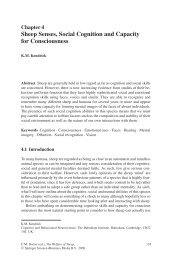Ulric Neisser
Ulric Neisser
Ulric Neisser
Create successful ePaper yourself
Turn your PDF publications into a flip-book with our unique Google optimized e-Paper software.
and pencils, were asked to duplicate the target as best they could. Their responses were then<br />
mechanically scored against that target, eliminating the possibility of error or bias. These<br />
experiments produced surprisingly positive results, so we published them in the Journal of<br />
Parapsychology (Kahn & <strong>Neisser</strong>, 1949).<br />
My interest in ESP did not last long. David Kahn and I later spent a summer doing ESP<br />
research at the American Society for Psychical Research in New York, but all our experiments<br />
there were failures. We couldn't even replicate the experiments we had carried out successfully at<br />
Harvard! This was discouraging, and I did not pursue the paranormal any further. It may be,<br />
however, that this early exposure to an exotic research area had a subtle influence later on. I have<br />
long had - and perhaps still have - a soft spot in my heart for exciting but unlikely hypotheses.<br />
Becoming a psychologist<br />
Meanwhile, I was a busy psychology major. It was probably in the history course that I<br />
was first exposed to conflicting theories, especially behaviorism and Gestalt psychology.<br />
Choosing sides immediately, I rejected the former and was strongly attracted to the latter. My<br />
antipathy to behaviorism stemmed not only from its dreary mechanical view of human nature but<br />
from the sheer fact of its dominance. I was already a committed infracaninophile, and Gestalt<br />
psychology was clearly the underdog in any department that included B.F. Skinner. I was<br />
particularly intrigued by the way that Max Wertheimer and the other Gestalt theorists viewed<br />
human nature "from above" rather than mechanically "from below." Köhler's principle of<br />
psychophysical isomorphism, for example, impressed me as an important new approach to the<br />
mind-body problem.<br />
Other courses brought me up to date. I took a lab course from Fred Frick and a methods<br />
course from J.C.R. Licklider, who insisted that statistics required "vigor, not rigor." Jerry Bruner<br />
and Leo Postman taught a course on perception and motivation, focusing on what was then being<br />
called the "New Look." A new course on language and communication, taught by my adviser<br />
George Miller, introduced me to linguistics and information theory. Miller encouraged me to<br />
take more mathematics, especially advanced algebra; he was sure the psychology of the future<br />
would require it. I took his advice, albeit without enthusiasm. Later I was one of two seniors (the<br />
other was Marvin Minsky) enrolled in a graduate seminar that discussed Hebb's new book The<br />
Organization of Behavior (1949).<br />
For my senior honors thesis I needed a topic far enough out of the mainstream to be<br />
"original" (which was very important to me then), but not so far out as to seem crazy (i.e., no<br />
parapsychology). What I came up with was obscure indeed: the influence of visual stimulation<br />
on the auditory threshold. A Russian psychologist had reported such an influence, but his results<br />
were not widely accepted. In my theoretically naive state, such an intermodal effect seemed<br />
attractively Gestalt-like. Miller helped me generously even though he wasn't especially interested<br />
in the hypothesis. Using standard psychophysical methods for the auditory threshold, I<br />
manipulated visual stimulation by turning the room lights on or off. The results were negative,<br />
but I got honors anyway.<br />
Swarthmore<br />
It was time to go to graduate school, and I knew just where. Wolfgang Köhler, one of the<br />
founders of Gestalt psychology, had fled Germany in the 1930s and was teaching at Swarthmore<br />
College. To attract Köhler, Swarthmore had also created a position for his colleague Hans<br />
Wallach and an M.A. program to provide them both with graduate assistants. The students in the<br />
5




